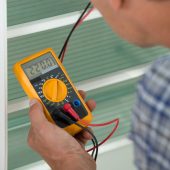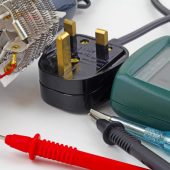Measuring earth leakage is important to protect people and electronics from electrical faults. A clamp meter is the best way to measure the current leakage.
But not all kinds of clamp meters can measure earth leakage. You need either a very high resolution clamp meter (which is pricey) or a special earth leakage clamp meter.
What is Earth Leakage and Why Do We Need to Measure It?
Earth leakage generally refers to any unwanted current leakage in a circuit. It often results from low insulation resistance (because of low quality, damaged or worn out insulation).
Long conductors (especially those over 250 feet) can also result in earth leakage because of increased capacitance.
Earth leakage is not always because of a problem in the circuit. Many appliances, mostly those with built-in capacitors, produce some leakage as part of their normal operation.
Your main electrical panel contains a residual current device or RCD, which protects your home and family from excess earth leakage. It trips and switches off power if it detects leakage beyond a certain threshold.
RCDs are designed to allow for a certain safe amount of leakage from conductors and appliances.
But if a fault in the circuit or an appliance produces too much current leakage, it automatically trips the RCD. Connecting many high-leakage appliances or electronics to the same circuit can also trip the RCD.
So it’s important to measure the total leakage in a circuit to make sure you don’t exceed the RCD threshold. This will prevent the RCD from constantly tripping and switching off your power.
Using a clamp meter, you can identify which particular circuit and equipment is producing the most leakage.
Measuring earth leakage is also important if you suspect there’s an electrical fault that’s creating a lot of leakage and causing the RCD to trip.
A clamp meter can help you track where the problem is. It’s probably bad insulation, a faulty appliance or something else.
Can A Regular Clamp Meter Measure Earth Leakage?
If you already have a clamp meter and want to use it to measure earth leakage, I have some bad news. Unless you have a high-end clamp meter, it probably cannot measure earth leakage.
The amount of earth leakage current is very low compared to load current.
For instance, it’s normal to measure a current of 20 amps flowing through a circuit. That’s easy to measure with a regular clamp meter.
But leakage current through the same circuit can be just 2 milliamps, which is 10,000 times less than the load current. Depending on which appliances are connected to the circuit it can even be as low as 0.2 mA or 100,000 times less.
Normal clamp meters are not designed to measure current this low. Low to mid-range clamp meters have a resolution of 0.1 amps or 100 mA, meaning they cannot measure anything smaller than that.
Even some expensive clamp meters with a higher resolution of 1 mA can fail to accurately measure very low current leakage.
So you cannot use a regular load current clamp meter to measure earth leakage. That’s because clamp meters are designed to measure large amounts of load current.
The exception is if you have a high-end clamp meter with a very high resolution such as 0.1 mA, meaning it can measure both high load current and low leakage current.
Load Current Clamp Meter vs. Earth Leakage Clamp Meter
The best way to measure earth leakage is using an earth leakage clamp meter. This is a clamp meter that’s designed to measure very low currents, sometimes as low as 0.001 mA.
An earth leakage clamp meter works the same way as a regular load current clamp meter, with the only difference being its ability to detect and measure very low currents.
Most earth leakage clamp meters can only measure a max of 60-100 A. So they are not ideal for normal current measurements on live conductors.
For that, you’ll need a regular clamp meter. Some models can measure as much as 600 amps.
There’s also a big difference in how you use a load current clamp meter and an earth leakage clamp meter.
With a load current clamp meter (the normal kind), you enclose the jaws around just one conductor. You want to know how much current is flowing through that particular line. Measuring more than one line at the same time produces incorrect results.
With an earth leakage clamp meter, you measure two or three conductors at the same time. That’s because you want to find out the difference in current between them. That difference is what we call earth leakage.
How To Measure Earth Leakage With A Clamp Meter
The first step is to make sure you have the right clamp meter. It should be a dedicated earth leakage clamp meter or a 2-in-1 earth leakage and load current clamp meter.
Measuring earth leakage is easy and quick. Turn on the clamp meter, open the jaws and wrap them around the live and neutral wires of a particular circuit.
Make sure you only measure one circuit at a time. Be careful not to mix the neutral of one circuit with the live of another one. You won’t get the right measurements.
Check the display to see the reading. Repeat for each circuit.
What’s A Normal Amount of Earth Leakage?
The amount of earth leakage will vary from circuit to circuit. Circuits with certain electronics like a computer, printer or router may display higher leakage current than other circuits.
But generally, most household circuits have a normal earth leakage that is less than 1 mA. But it can be as high as 3-5 mA for certain circuits.
The total earth leakage should not exceed 30% of the rated residual current of the RCD. So if you have a 30 mA RCD, the total earth leakage should be no more than 9 mA.
How To Track Down the Source of High Earth Leakage
If you are getting a high earth leakage measurement, try to figure out where it’s coming from. This is easy to do with trial and error.
First, identify which circuit has the highest leakage. Then, switch off appliances or equipment that are on that circuit one by one while checking the change in earth leakage.
The appliance that causes the biggest drop in leakage is the culprit. Have an electrician check whether it has an issue.
Can You Measure Earth Leakage Using the Earth Wire?
Most of the current leakage in your home is through the earthing. So why can’t you just measure how much current is flowing through the earth wire?
That wouldn’t give you an accurate picture of the total amount of leakage. That’s because current doesn’t just leak through the earthing. Some current can also leak through other paths such as water pipes or concrete.
Clamping the meter around just the earth wire doesn’t measure these extra leakages. So you won’t know the actual total earth leakage, meaning you might be having excessively high leakage without realising it.
An RCD works by measuring the difference in current between the live and neutral wires. So that’s what you should also measure.
For more on earth leakage and how to measure it, here’s a great explainer video.
How To Reduce Earth Leakage
If your RCD keeps tripping because of high earth leakage, work with a licensed electrician to find the source of the problem and fix it. Here are some of the things you can do to reduce earth leakage current.
- If the high leakage is caused by a faulty equipment or appliance, repair or replace it.
- Divide circuits between multiple RCDs to stay below the 30% threshold.
- Your electrician may recommend a partial or complete rewiring to fix the problem.
- Check for any insulation issues and fix them.
Your electrician may also recommend installing certain devices such as filters or an RCBO (Residual Current Breaker with Over-Current).


